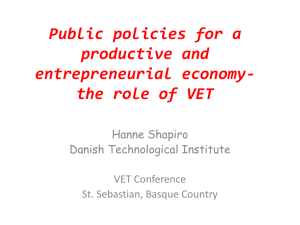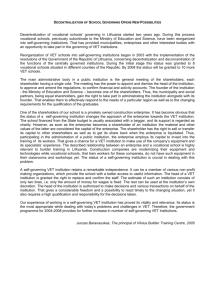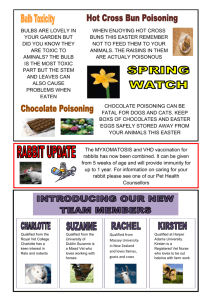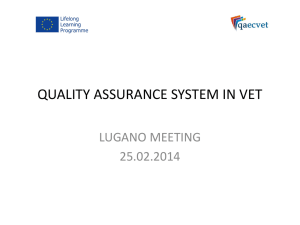Qualifications and Pathways: Vocational Education
advertisement
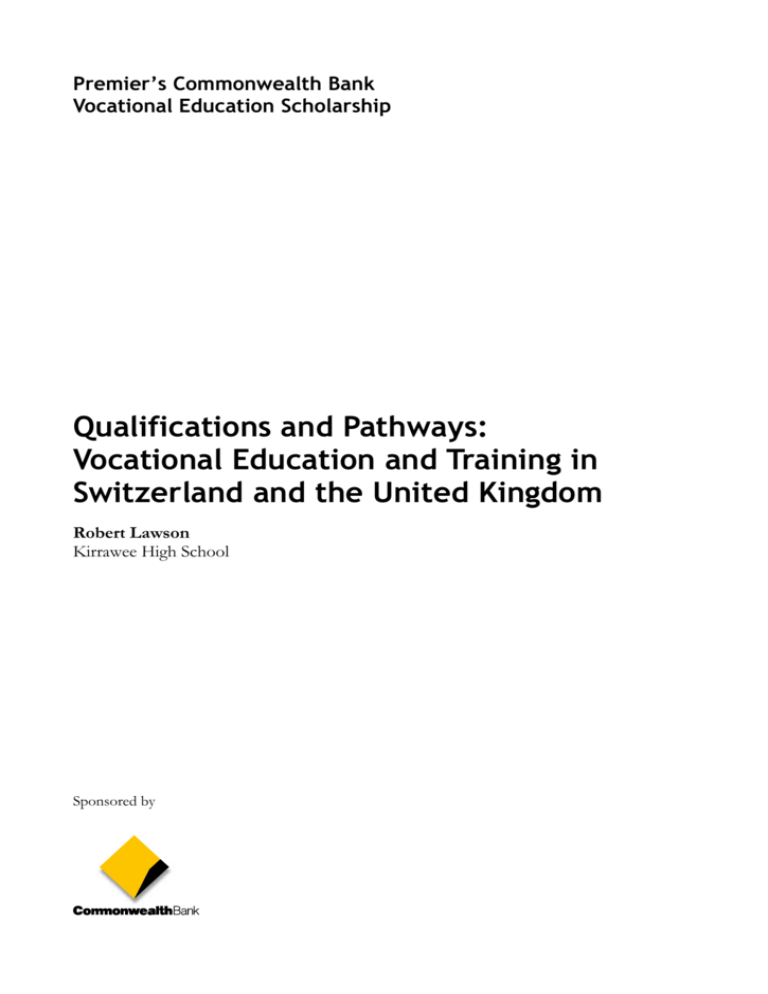
Premier’s Commonwealth Bank Vocational Education Scholarship Qualifications and Pathways: Vocational Education and Training in Switzerland and the United Kingdom Robert Lawson Kirrawee High School Sponsored by Vocational Education and Training (VET) has been a passion of mine for over 35 years, starting from when I entered an apprenticeship in commercial cookery at the age of 16. Over the last 20 years I have delivered hospitality courses for TAFE and the Catholic Education Office, and I am currently employed by the Department of Education and Communities. Focus The focus of my study tour was to look at the vocational qualifications being delivered in Switzerland and the United Kingdom and how they articulated to further education and/or employment. I also investigated how industry and business organisations influence the skill level of the qualification being delivered. I chose Switzerland as they are regarded as the world leader in the delivery of VET subjects and its connections to industry and employers. The UK has just undergone a governmental review of its VET delivery, resulting in a number of recommendations and new priority areas. While in Switzerland and the United Kingdom, I: visited secondary schools to establish how VET programs were delivered, and articulation pathways and their perceived value to both the school’s curriculum and students attended meetings with business associations who represented or supported vocational education attended meetings with government departments who manage VET in their respective regions or countries visited vocational colleges and universities observed students working and being assessed and had the opportunity to discuss their VET programs. This report will be divided into three sections: 1) vocational education and training in Switzerland. 2) vocational education and training in England and Scotland. 3) conclusion Vocational Education and Training in Switzerland My research into VET delivery in Switzerland led me to the conclusion that Switzerland would be a valuable country to visit and I was not disappointed. From my first meeting I was impressed with the way VET was so highly valued and provided participants with high quality outcomes. I must thank Ms Marie-Laure Farve from the State Secretariat for Education, Research and Innovation (SERI), who organised meetings for me and took time to present information on the training system in Switzerland. Ms Farve’s assistance and access to her contact network was extremely valuable. I had a full itinerary in Switzerland that started with a meeting with a recently qualified agriculture student, Nadine. Nadine completed 9 years of primary and secondary school and then commenced an apprenticeship. Her training took three years and her fourth and final year was a practical experience based on her area of study, agriculture. Of interest was that she spent her year on a property in Albany, Western Australia. The property produced fat lambs and did some cropping. She is currently back in Switzerland training in agronomy to add to her skills and knowledge. This surprised me as I presumed that she would get straight into work, but the concept of furthering your skills and knowledge was considered valuable and strongly supported by industry and tertiary institutions. Nadine felt that her trade was highly respected and the qualifications she held were relevant and placed her in a good position for employment. Nadine also felt that a VET pathway was viewed as a socially preferred transition into the workforce and provided more opportunities than an academic pathway. This meeting left me with the impression that what has been described was the opposite to the Australian VET system in that: VET pathways in Switzerland are considered a preferred option socially, financially and educationally. Meeting two was with Mrs Nicole Meier, Head of Marketing and Sales Education of Hotelleriesuisse. Hotelleriesuisse is the head of the Swiss Hotel Association and a training company. Hotelleriesuisse has a college in Adelaide and is heavily involved in discussions on the level of qualifications in Switzerland compared to other European countries. Switzerland call their VET courses Diploma Courses and are compared to other countries that call their courses Bachelor Courses. Some feel that the Swiss courses are delivered to a higher level than those of neighbouring countries but are less valued due to the name. Portability of qualifications has been identified as an issue in the Swiss training system also due to the qualification name and the perception of it being of a lower standard. I was also told that professional development or ongoing training was expected from all employees and that businesses pay into a fund that is used to support staff and pay for training. Nicole listed the system’s strong points as the dual system: Tertiary A, which is academic and is taken up by 10 to 15 per cent of students; and Tertiary B, which is the practical based VET subjects. The fact that Switzerland is also known for the quality of their VET training is also a strong point. Nicole reinforced the impression I had from my first meeting, that VET is the preferred option in Switzerland as evidenced by: 85 per cent of students in Switzerland following a VET pathway and are more likely to gain employment and have a higher earning capacity. Next was a visit to SERI to meet with Ms Marie-Laure Farve, who is the Project Manager, International Education Projects. Ms Farve provided me with an overview of the training system The Swiss Education System in Switzerland, which also included data on benefits to the individual, society and in earning capacity. There were several key facts in her presentation: Up to 85 per cent of students choose a VET pathway. In 2012 there were approximately 93,000 graduating VET students and up to 95,500 positions available to them. VET graduates earn 10 per cent more than conventional university graduates. Industry has a very strong connection and influence on training. Completion rates are 90 per cent, but the targets are 95 per cent. The two most respected and well paid professions are police and teachers. I left this meeting thinking I may be in a VET teacher’s heaven, a country that highly values and rewards VET occupations and teachers. Next on my Itinerary was a meeting with the Swiss Federal Institute for Vocational Education and Training (SFIVET). SFIVET has three main roles in the Swiss VET system; these include: development of VET programs development training packages training of VET teachers at all levels from Secondary to Masters I met with Mr Erik Swars, Senior Manager, International Centre for the Development of Occupations, and he provided information on the development of VET curriculum and teacher training. In Switzerland the curriculum of each VET subject must be updated at least every five years, although Erik did comment that this happens every 3 to 4 years or as new technologies are introduced. The changes are directly influenced by industry organisations in collaboration with the cantons (states) and government departments. Erik felt that the level of collaboration Mr Herbert Binggeli, Bern University of Applied Sciences. between all stakeholders when developing training packages is a strength in the Swiss VET system. I had a great meeting with Mr Herbert Binggeli, the Rector of Bern University of Applied Sciences. We discussed everything from student attitudes and motivation to the influence of professional associations on curriculum and teaching. He once again confirmed that the VET pathway was both highly valued and led to more employment opportunities and higher remuneration. Mr Binggeli said that ‘VET occupations have over 400 years of tradition and are culturally embedded into the Swiss way of life.’ Mr Binggeli explained that presently there is a discussion on academic students changing to a VET pathway at university level. He feels that before an academic student is allowed to enter an applied university they should spend between 6 and 12 months employed in a trade area. The academic student are arguing that they can do this at the end of the course, but Mr Binggeli feels that students need that practical understanding of the trade to fully appreciate the course. Skilling and then being involved in industry research is a large income generating process for the university. Bern Applied University has several faculties and their students working on funded research programs and is considered cutting edge in many areas. I met with Ms Christine Davatz from the Small and Medium Business Association. Ms Davatz stressed the input that the professional associations have on the Swiss education system. One Mission - Three Partners is the vision statement that is used when describing the relationship of the partners in education. The three partners are VET Schools/Colleges, Confederation, and the professional organisations/companies. When discussing industry input into curriculum development, Ms Davatz stated that professional associations define what needs to be included in each training package. She went on to say that you cannot have a trade without a professional association. My last meeting was with Mrs Sonja Morgenegg-Marti, Director of Gewerblich-Industrielle Berufsschule Bern (GIBB), Bern Vocational School. I was met by Mrs Morgenegg-Marti in her office and she explained that the college had 7,500 students and close to 800 staff. The school is based over several campuses and operates during the day, night and weekend. Once again I was told how valued VET is and how good employment rates are on completion of courses. Many of the staff are part time and up to two-thirds are still working in their trade. I asked how much industry contact the teachers have and was told that she insists that every student’s workplace is visited by the teachers. She said that all heads of departments must meet regularly with the related industry associations to ensure that associations are happy with the curriculum being delivered at the school. This all ensures that the school is delivering up-to-date and valid curriculum. Key Points I would like to reiterate the statement that Mr Herbert Binggeli, the Rector of Bern University of Applied Sciences, made: ‘VET occupations have over 400 years of tradition and are culturally embedded into the Swiss way of life.’ Vocational education and training is a way of life in Switzerland, with students being told by their parents that they will enter into a trade from the time they are able to talk. Industry is vital to VET and this is supported by the fact that there cannot be a trade without an industry association to support it. Industry and business support education and training financially and maintain the need for continuing professional development, which is seen as the responsibility of all employers. All articulation pathways are clear and the dual system has the flexibility to allow VET students to cross over from academic to VET or VET to academic education. All teachers/trainers are required to keep close contact with their industry and local employers. Vocational Education and Training in England and Scotland After arriving in England my first meeting was at Aylesbury College. I met with Ms Fiona Morey, Vice Principal, Learning and Quality, who was very generous of her time and provided an interesting insight into Education in the UK. We had a very similar conviction to public education and were both surprised that our schools faced similar issues and challenges. I was then introduced to Ms Teresa Stroud, Curriculum Director, Student Success, who was kind enough to walk me through the college's facilities. My colleagues in Australia would love to have the opportunity to deliver in such great learning environments. From the beauty salon to the restaurant and kitchens, all were of high quality. Next was the highly energetic and enthusiastic Ms Nicky Austin, Curriculum Manager Hospitality and Catering, who walked me through the café, restaurant and kitchens where two students were taking a catch up prac test. Nicky and I discussed everything from industry currency and qualifications to swapping jobs for a month (it would have to be summer in the UK). The college opens many of its facilities to the public and charges minimal fees for services such as hair and beauty. The restaurant is open for breakfast, lunch and dinner with the innovative approach of the college by employing students as apprentices. I next had meetings with representatives from Amersham and High Wycombe colleges. I have often said that schools and individual faculties are becoming more like businesses competing for clientele. The college system in England is an example of educational facilities becoming a business. Colleges have complete control over finances (based on student numbers), who they employ (including staff’s level of qualification), and the amount they pay staff. Individual colleges can train teachers and will often have trades qualified staff providing practical lessons and the theory components delivered by qualified teachers. The colleges do have great industry networks and support. Courses being delivered are influenced by the communities’ context and local skills shortage areas. I was able to meet some staff who were working on a newly established partnerships, including a new program with a movie studio that is working on Star Wars. This is an example of the flexibility the colleges have as the movie studio identified a skill shortage and the college developed a course to meet the studio’s need. Another example of how closely the colleges worked with industry was when the mechanical students were asked to work with mechanics at an international car racing circuit. A high performance mechanics module was developed by the college in conjunction with the motor racing teams and is now delivered to students. Other partnerships included the Hospitality Department working with Wembley Stadium and a large local horse racing track. While in High Wycombe I visited Cressex Community School and spent some time with Ms Jane Everton, who was the acting principal. The school was delivering VET subjects on site by contracting external providers to deliver programs. After monitoring of the content being delivered and trainers’ lack of appropriate qualifications, it was decided that the courses were not being satisfactorily delivered. As the school considers VET subjects are very important for their students, Jane is looking at how students can better access courses. The ability to attract and hold suitably qualified VET trainers was identified as an issue as the maximum a school was allowed to pay a VET teacher was twenty thousand pounds, which was well below the pay rate to work in industry. I had the opportunity to meet with Ms Sue Clarke from the Department of Education UK at the department’s offices in London. Ms Clarke heads up the Vocational Education Division and has been in the middle of a turbulent period of changes in the delivery of vocational education. After an extensive review of the delivery of VET in schools by Professor Alison Wolf, several key points were identified that needed improvement, including: Of the 3,700 qualifications that could be delivered in schools only approximately 140 were deemed appropriate. Literacy and numeracy skills must be improved (must meet at least a C grade). VET courses should add to a student’s score. Funding formulas need reform. Ms Sue Clarke, Vocational and Education Division, Department for Education UK. Performance indicators and minimum standards need reform. Study programs need to include work experience. Pathways to higher levels of qualification need to be provided. Professor Wolf made 27 recommendations and the current government in the UK has accepted all 27 and are working on their implementation in whole or in part. Many of the recommendations are expected to raise the profile and value of VET in the UK. VET students were entering courses that had no value or were irrelevant to the industry that they were supposed to be preparing students for. An excerpt from a speech delivered by the Minister for Education stated: ‘Students studied certificates in low-value subjects like ‘working with others’ – that falsely claimed to be the equivalent of A levels – or studied certificates that were simply useless: like one in ‘sports development’ that wasn’t recognised by employers, didn’t qualify you to work in a leisure centre or gym, and didn’t get you a place on a sports degree at University.’ Teacher qualifications and course content have also been identified as areas of concern. In fact, one high school I visited was delivering VET programs in school but had discovered that the course was being poorly delivered by unsuitably qualified people. Oban High School and Lochaber High School are situated in the Scottish Highlands and are very similar in that they do not deliver VET programs in school but have developed very close relationships with their local colleges. Lochaber’s local college offers five courses for students to choose from. Students spend one day per week in college and the school’s principal, Mr Jim Sutherland, reports that all construction and childcare students have found employment as a result of completing their VET course. Mr Sutherland stated that VET courses were valuable for student engagement and retention and are more popular with the less academic students. Oban High also valued their relationship with their local college, who also deliver courses to suit the context of the high school. Up to 30 per cent of Oban High students articulate into college at the end of high school which assists with engagement and retention. Key points include: Both colleges deliver courses to suit the context of the school; for instance, Lochaber is surrounded by mountains and waterways so Outdoor Recreation is delivered. Both schools have close relationships with the colleges. Courses are delivered in stages that promote articulation from school to college. Oban has some issues with students attending college on time and regularly. Clyde College Glasgow Clyde College is a multi-campus college with three sites in Anniesland, Cardonald and Langside. Glasgow Clyde is one of Scotland’s largest further education institutions and delivers to 7,000 full-time students and 20,000 part- time students. I visited Cardonald Campus, which is the largest of the three, and met with Eleanor Harris, Deputy Principal and VP for Curriculum and the head teacher of the industrial arts section. The college has strong links with trade associations, which have an input into the curriculum being delivered. The college also has strong links with large employers such as Scottish Power, Rolls Royce Scotland and Scottish Water. The colleges also have close links with local secondary schools as the schools will negotiate subjects that suit their individual context. Students attend colleges for VET subjects similar to our TVET students. Colleges do have the issues of students being sent to do courses that they are not suited to or have the ability to complete successfully. With such large numbers, travel corridors for school students are also an identified problem. Skills Development Scotland Skills Development Scotland are a government funded organisation that have several key areas of responsibility: to provide information on training opportunities on offer to learners to maintain their course search tool on My World of Work, the most comprehensive learning opportunities database in Scotland to work with stakeholders to develop VET qualifications based on occupational standards to deliver employability programs to provide a forum for training providers to promote their courses to learners through the website and helplines The Scottish government have set targets for establishing 25,000 new apprenticeships to be commenced this year and increasing to 30,000 in coming years. Problems that have been identified with the VET system include: on-going problems with the quality of work experience problems with UK government due to different views and perspectives as the context of employment and training is different in Scotland compared to England. continued employment of trainees and apprentices after the Commonwealth Games. Conclusion I am very grateful to have been given the opportunity to undertake this study tour and I now feel more empowered when discussing VET issues and points of difference in the delivery of VET internationally. The VET system in Switzerland is highly valued by the whole community and leads to more employment opportunities. It is head and shoulders above the academic pathway when it comes to student choice. All stakeholders are committed, engaged and take great pride in their system. Vocational careers and training are culturally imbedded in the Swiss way of life and it would be extremely difficult to implement a Swiss style system in Australia. The UK is very similar to Australia in that VET is considered a less favoured option by the majority of educators and the community. Both the UK and Australia are undergoing changes and are implementing strategies to improve the value and profile of VET. Literacy and numeracy has been identified as a key issue in the UK along with the need to deliver courses that are relevant and lead to real opportunities in the workplace or further education. The business model at the colleges I visited required strong partnerships with industry, knowledge of the local community and the ability to react to skill shortage areas. Qualification options have been pared back and now enable clear articulation pathways to the workforce or further education. Both the UK and Switzerland have demonstrated the importance of industry engagement, clear articulation pathways and the delivery of qualifications that are valued by all stakeholders. I have both enjoyed and appreciated this professional development experience and would like to acknowledge the support from the staff at Premier’s Scholarships Secretariat and the Commonwealth bank.




